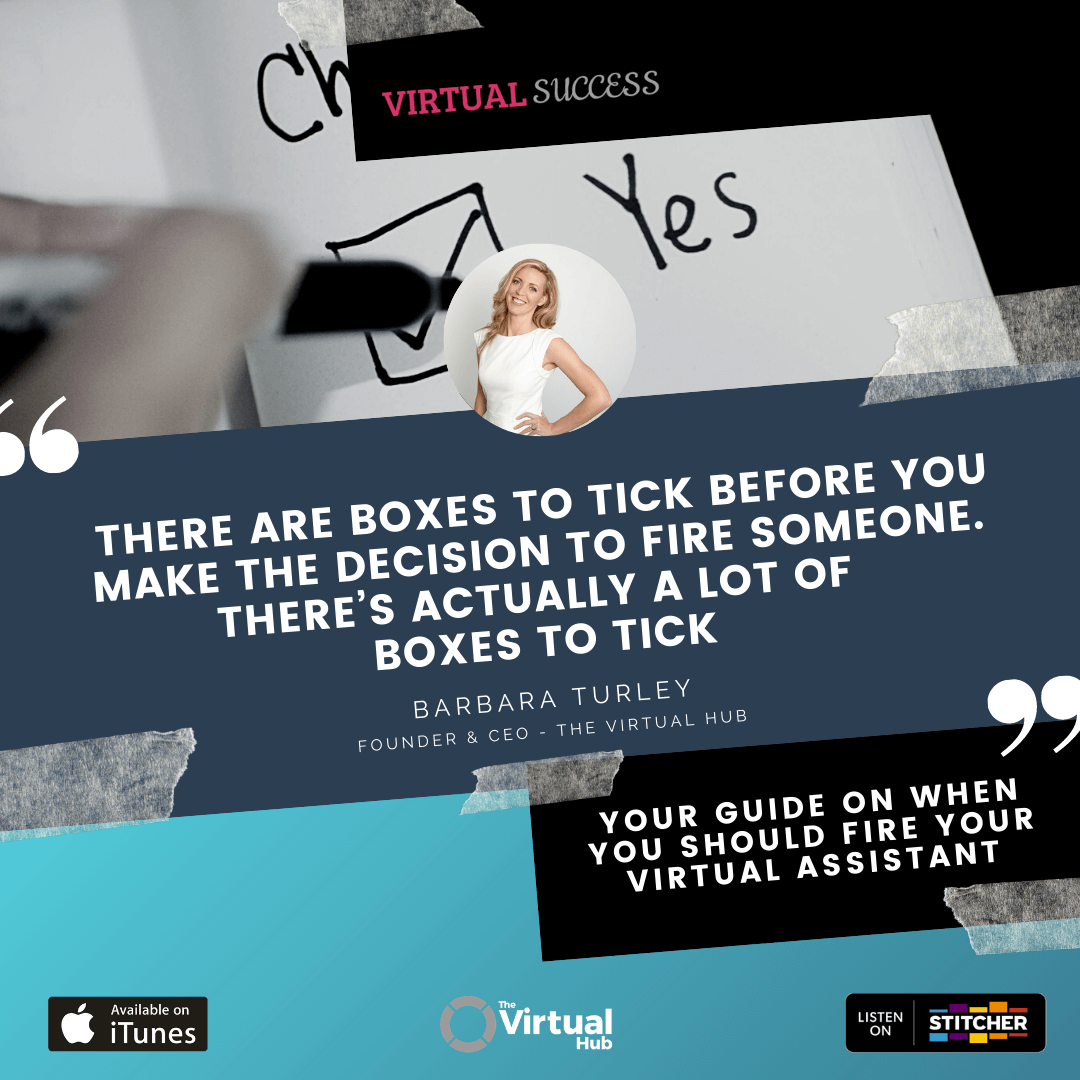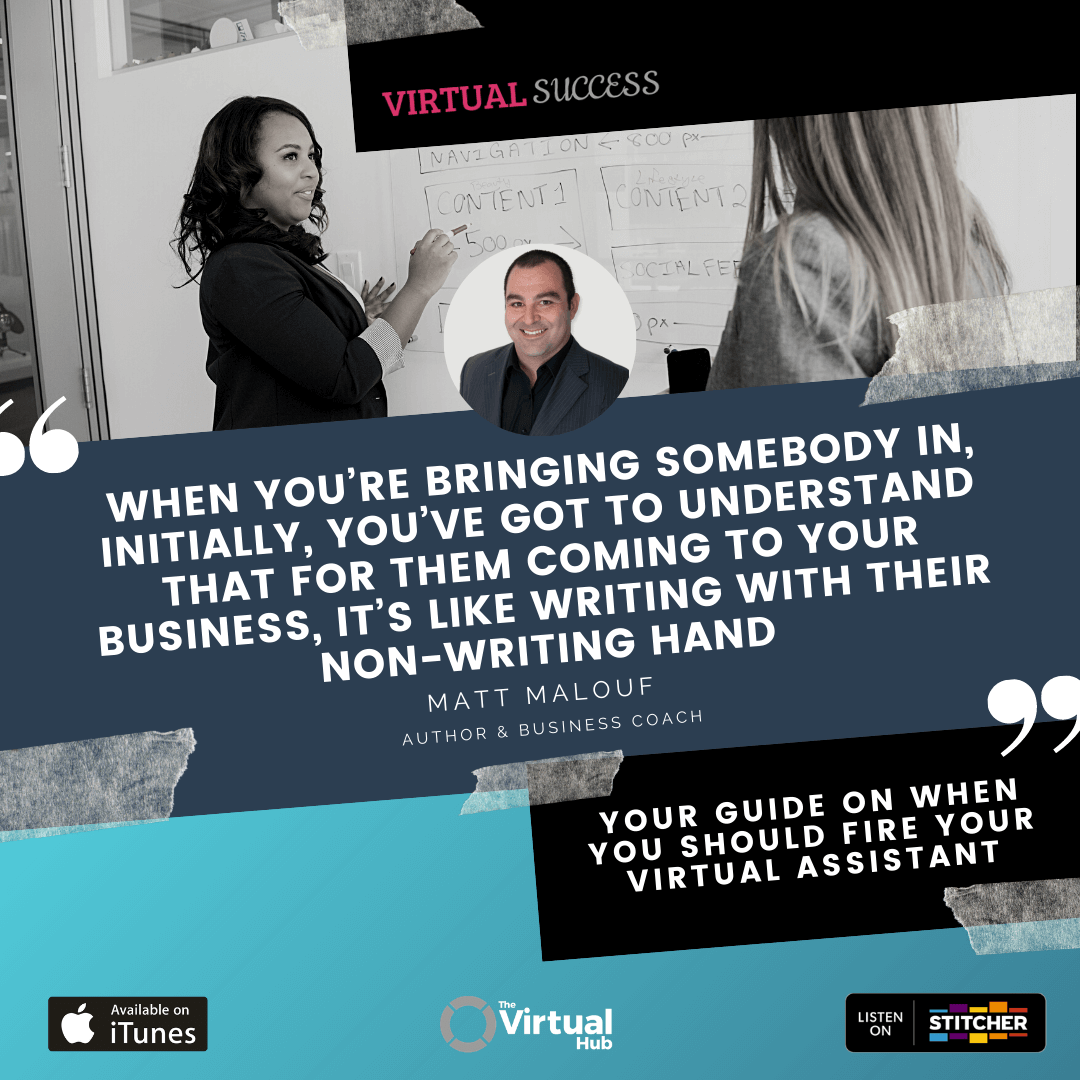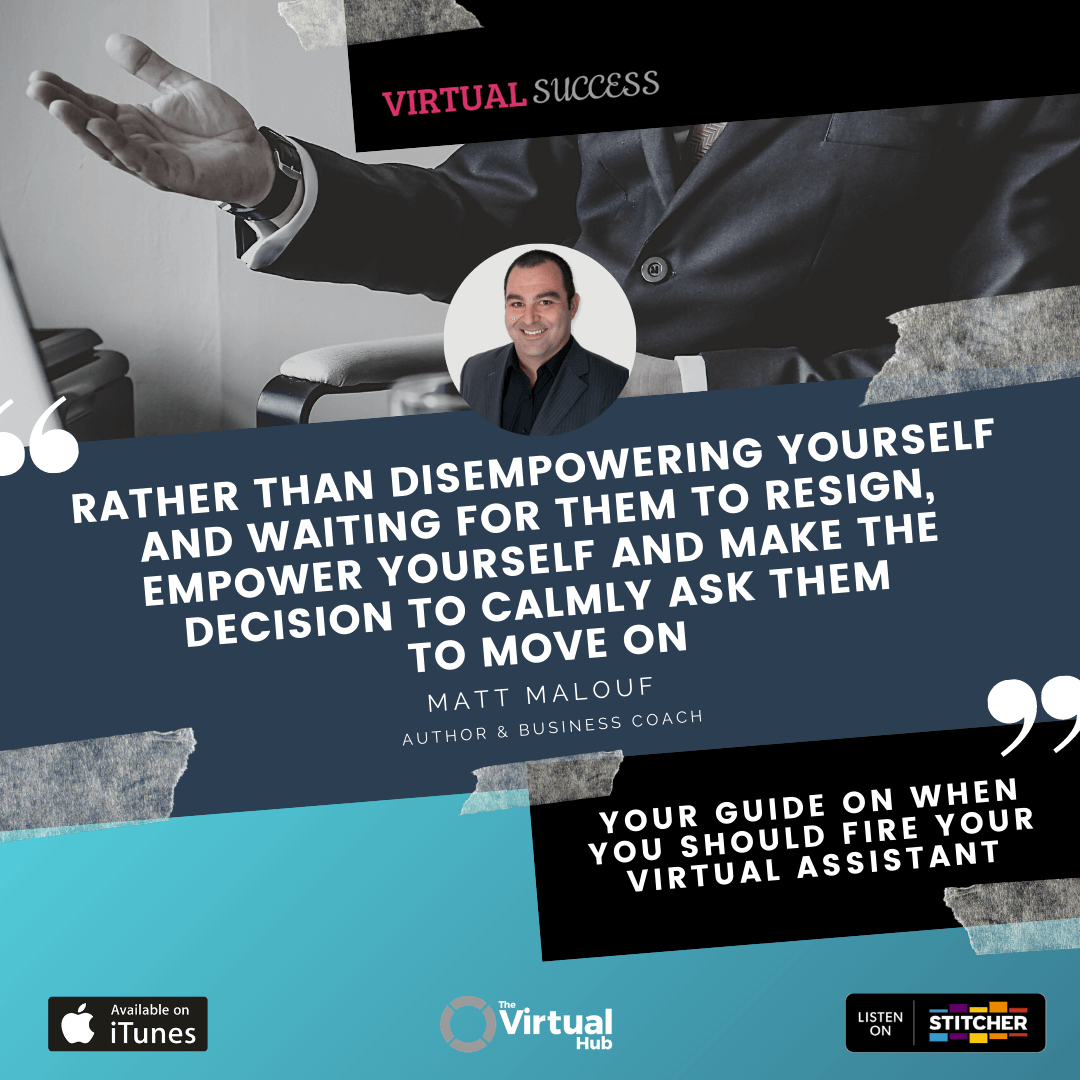When Should You Fire Your Virtual Assistant
Want the transcript? Download it here.
In this episode, Matt and Barbara talk to listeners about the often-avoided topic of when to fire your Virtual Assistant and help business owners understand the situations when it may be necessary.
This episode focuses on the some of the tough situations business owners may find themselves in with their VAs and why letting them go can be the best outcome not only for them, but their business as a whole.
Some of the areas covered include:
- Avoiding the Churn & Burn – hiring and firing VAs over and over again
- The importance of having sound systems, processes and tasks lists
- Assume nothing, clearly communicate everything
- The need for meeting rhythms and clear accountability criteria
- Setting clear parameters around what your ‘non- negotiables’ are
Let us know what your key takeout has been from this episode and join the continuing conversation over in the Virtual Success Facebook Group.
In this episode:
01:16 – When should I fire my VA?
02:26 – The Churn & Burn
03:08 – Flawed task lists
03:40 – Effective communication
05:53 – Setting your VA up to win
07:09 – Holding your VA accountable
08:04 – Meeting rhythms
09:41 – Making the decision to fire a VA
10:40 – Getting clear on your standards
13:06 – What are your ‘non-negotiables’?
16:53 – Wrapping things up
Resources mentioned in this show:
Matt: Hi everyone, welcome to another episode of the Virtual Success Show, where I’m joined by my co-host, Barbara Turley. Good afternoon Barb.
Barbara: Hey Matt, how are you?
Matt: I’m excellent. How are you?
Barbara: Good thanks, good thanks.
Matt: Good. I’m really really excited about today’s show, and the reason I’m excited about it is because I think it’s one of those topic areas where a lot of people avoid the conversation, and the conversation we want to be having with you all today is understanding when to fire your VA. When is it time to let them go? And I’m excited about this only because it’s one of those areas that often is not discussed until it’s too late.
When should I fire my VA?
Barbara: Absolutely yep, and I see that happen a lot within our business, you know, for clients it’s a difficult area … And also there’s sort of two things I want to touch on with this topic. There’s when to fire your VA. Sometimes people fire them too early as in you sort of get into this churn and burn cycle of they’re not good enough, get a new one, they’re not good enough, get a new one. And then other people we find, try really hard and probably allow things to go on way too long until the point in which they’re getting railroaded by someone. So, sometimes, I mean obviously by the nature of my business, I’m very pro-VAs on these podcasts, but I’m also very aware that sometimes you have done all the right things, you’ve followed all the things that we talk about, and you actually just have a person who’s not either good enough for the role, or who is actually doing the wrong thing by you as an employer. And that’s a tricky thing to face.
Matt: Which one are we going to start with Barb? Let’s start with the churn and burn.
The Churn and Burn
Barbara: Yeah, because this is a common problem. So, when … Often we see people hiring someone and they just decide very quickly after two weeks, oh they’re not good enough, it’s just not going to work out? And really I think there are boxes to tick before you make the decision to fire someone. There’s actually a lot of boxes to tick. Sometimes … I mean there’s so many shows we’ve done on this, sometimes it’s people who you’re … You’ve no processes in your business or you’ve no systems and you’ve tried to kind of just offload a task list on someone and they don’t even know how to find your files or navigate your business. So that’s the kind of … The most basics of major problem.

Flawed task lists
Other times we do see people, and you’ll see this as well Matt, people who have got processes, or task lists, but they’re too vague. So there’s a lot of holes in them, which is a major problem. And what happens is, is that you delegate that to somebody, they take it on, and it’s full of mistakes, and you can’t understand why, and you want to blame them. But you probably have a good person, it’s just that there are holes in the processthat … You can’t see and they don’t understand, basically from the process problem.
Effective communication
And the final one I guess, and we’ve done a three part series on this, is communication, and understanding the learning style of your person that is working with you, how you communicate effectively with them for win-win situations, how to give effective feedback, and I would encourage anyone listening to this, that we’ve done shows on all of the things that I’ve just talked about so, I guess you’ve got to take those boxes first before you get into the when to fire someone. Matt would you agree, or what do you think about … ?
Matt: I do and I think that if in the first two weeks, you’re thinking you want to get rid of your virtual assistant, then you’ve really got to sit down and go okay, let’s dissect this. What specifically aren’t they doing, that I thought they would be doing? Have I communicated my expectations clearly enough? As Barbara was just talking, is it the system? And so you’ve always got to come back and go, this person may be trained in this particular tool, is it the way we’ve documented or the way we do it, that’s different, and they’ve got to learn?
One little thing I get people to do in coaching sessions, which I think highlights this for a lot of people is, if you were to get a pen in your non-writing hand and I ask you to write your name, you would have to really focus, and you know how to write, you know how to spell, but you’re not used to writing with your non-writing hand, versus when you put the pen back in your writing hand, and you write your name and you can probably do it with your eyes shut, would be neater than with your non-writing hand. And when you’re bringing somebody in, initially, you’ve got to understand that for them coming to your business, it’s like writing with their non-writing hand, and your you, particularly if it’s your first time using a virtual assistant, it’s like you writing with your non-writing hand also. So, often there’s not enough energy that goes in to make it work. There’s too much assumption that, oh well, this person presented an amazing resume, and they’ve got this experience, they will just know what to do.

Setting your VA up to win
I repeat this often in this show, whether it’s locally or overseas, in your office, virtual remote, it’s the same. You’ve got to make sure you set people up to win. And I think that too often in business is people are moving so fast, there’s so many things happening, and they’re juggling so many balls, that they sort of throw a ball to someone and expect them to know what to do with it.
Barbara: And you know what this is for people who are experienced as well. I’m just thinking of roles I’ve brought into my business, that are not just in the Philippines, and I’ve had to allow time for sales people to pick up the script, and to get it right and to fail at a few sales calls before we nail it. And it would be very easy to just say, oh they’re useless, get rid of them, and then to get the next person in and churn through that person and … I think sometimes if you’ve churned through more than two to three people, then it’s time to start looking back in the mirror, rather than blaming everyone else potentially, at that point. If it continues to fail for you.
Matt: Because the common person in all three scenarios there is you.
Holding your VA accountable
Barbara: Yeah, so let’s move on now to … There are times when, let’s be honest, you either have a person who is slippery, that’s the word I use. In a virtual environment, people can be slippery, right? And what I mean by that is they can say they’re there and they’re not and they can say they’re doing work and it’s not done, and really the way to unearth this is to have a process in place that unearths it for you. Now, what do I mean by that? So, I’ll be open I’ve fallen into this trap myself a few times, where I’ve been … I’ve had slippery people on the team, or I didn’t have the oversight process nailed enough in order for me to be able to pick it up without being emotional.
Meeting rhythms
So, what I’m saying here is that … And we’ve talked about shows … We did a recent show about meeting rhythms and how often should you talk to your team and all that sort of thing. And one of the things that I found in my business that unearths this is if you have … We have a weekly huddle with the entire team. And we have rules during the week around … Everybody has their processes and their task lists laid out and what the expectation is. And one of my expectations in my business is that everybody collaborates inside of Asana, which is the project management tool that we use, so that everybody is speaking to the necessary people within the task comments. So, you have to update everyone there. And then on the weekly huddle, you need to come to the huddle prepared, and you need to update the entire team on where you’re at, where your roadblocks are, and what’s stopping you moving forward.
And then a final piece of that whole puzzle, is I do actually … Everybody has to file things on our company G-Drive within certain folders, now this is a fairly new thing I’ve brought in, because there was too much sharing of files and people saving stuff all over the place where you couldn’t actually find the damn thing, and you couldn’t see whether it was actually done. So, and they have to drop the links to those folders in the comments section of Asana so that people can quickly, and me as the owner, can quickly scan the comments and then I can click into something and actually see the work. So I can have a level of oversight. Now in that environment, it is very difficult for somebody to hide. And it’s very apparent if work isn’t being done.
Making the decision to fire a VA
So I have had a situation quite recently where it was very apparent that a couple of people on the team just were not actually, they basically weren’t doing the work and it was very easy to see it. And I think in that situation, we had addressed it in other ways, initially, to try to mentor them and try to see was there a deeper problem with them emotionally or were they feeling like disconnected from the team, or the culture? And it actually got to a point where those…it just became very obvious that they were slippery. They were not doing what they said they were doing and, for all the wrong reasons. And we moved to remove those people from our team. So, I think in a situation like that it is time to stop the excuses, because excuses will come, and it’s time to make a business decision that is unemotional about the fact that for whatever reason, that person is not able to deliver and is not delivering.
Getting clear on your standards
Matt: And just to add another example on this, I remember a few years ago, we hired someone to come in and do some marketing for us, and they were actually in The States, so in the interviews we had negotiated ‘ok, given the time differences, this is our start time, this is your finish time’, that we both agreed on. And we agreed that you login to Slack, and make everyone aware that you’re…just say good morning, basically.
Barbara: Yeah, yeah.
Matt: Morning one, nothing happened. I reached out after about an hour and a half after they were supposed to start, ‘oh yeah yeah yeah I’m here, I’m sorry I forgot to write it’. No worries.
Morning two, same thing. No message. And I made it very clear that being on time and making everyone aware that you’ve started, is really important.
Morning three, happens again, and I was like, you know what, I don’t think this is going to work, and kindly, we ended it there.
I think what you’ve got to get clear on is what’s non-negotiable for you. And, in certain roles we have in our business, start and finish time is not an issue. You can do the work whenever, as long as you hit the deadline. But in other roles, when you’re working with others, knowing that they’re there, and they’re on, and we’re all able to start work at a certain time, and that’s the agreeable standard, is really important. And in that particular role, that was the agreeable standard. And you know what, I think if in the early parts of a job, you’re not going to meet the standard, then it’s probably not likely to happen at all through the job. And so, we cut it off real quick.
And I just wanted to give that other example where you’ve just got to get clear on your standards, and I think it’s … Yeah we could have … Yeah this was a classic case of on paper this person was outstanding. Right! Credentials through the roof, experience through the roof, but they weren’t respecting the standards that we had in our business. And your standards or values are critically important. And if you don’t uphold it then nobody will actually stick to it. And so we made that decision, and we made it real quick cause it was really important I think, in that instance, to do that and make that kind of decision quickly because it sends the message to the whole team, this is what’s acceptable and this is what’s not acceptable, and these are the rewards and these are the consequences.
What are your ‘non-negotiables’?
Barbara: Yeah, and you know, thinking my non-negotiables, I let a lot of things … There’s a lot of things I don’t mind. I’m not a big fan of flexitime, even though I always thought I would be, because I think it’s human nature. What I have found is that when I allow certain people, it depends, but in general with my team, anytime we’ve tried flexitime, I’ve noticed tasks getting done at 2 o’clock in the morning, and for me that’s not acceptable because mistakes are happening. And sometimes deadlines are being, you know…it’s too close to deadlines for my comfort level. So I’ve actually stopped all flexitime with my team, we have agreed times that we are working, and we can move it around if they need to, but we have to agree what they are, what the hours are.
And the other thing that is non-negotiable for me is the team communication. So within Asana, I just, I’m like, even if we talked about it on the call, you have to update the task, so that the team … And it fosters this sense of team collaboration, because we need team players in our team. So if somebody is not going to those levels for me, we’re moving towards a bad cultural fit even if they’ve got the skills. They’re not understanding the expectations of our culture and why we’re successful as a team, and that for me is when we move to have the conversation, ‘Is it going to work? Are you going to be able to deliver?’ We try again one more time and then if it doesn’t work, we’re out. That’s what we do from now on.
Yeah, so it’s a tricky one but I have noticed a few clients as well … And I feel sorry for the clients that fall into this trap and I know there’ll be people listening on the call, that’ve done this, where they try and they feel bad for the person and the person spins a story as to why, you know, the personal issues and whatever they’ve got going on. You know what? Reality check, we all have personal issues doesn’t matter if we’re in the Philippines or Australia or in the UK, or wherever we are, life is life and we have things that happen. And you can listen to the sob stories or the excuses, and you can continue to be frustrated, or you can create some expectations and non-negotiables and parameters around what it is that you require, and then if the person isn’t meeting those things, it’s move on.
Matt: Absolutely.
Barbara: And just be business-like about it and not emotional.
Matt: Yeah, and you know, as long as you set the expectation clearly from the start, then you’re only holding them to what they’ve agreed to. Often, if somebody doesn’t know something, you may sit there and give them that second chance, and take responsibility, but all in all, people will…if they’re the wrong cultural fit, then it might mean they need to go, they need to go fast.

Barbara: Yeah, and look if anyone’s listening and thinking yeah, I’m going to implement this now with my team, I will warn you that you will ruffle feathers, and it’s a good thing.
So recently, I sort of up leveled, Matt and I were talking about this off air. I’ve had this massive up leveling in my business that’s been a good thing, in terms of the structure and our organisational structure. And it opened Pandora’s box, in that we had a few…it unearthed some risks and some issues that we didn’t even know we had with certain people. Although those people are now gone, it actually was a good thing, because we have moved to another level of expectation and professionalism, and I think it was a really good thing, but it was a difficult period. So, if you’re about to do this, the current people that you have may run a mile, and usually if they run a mile, it’s because there’s something hiding, that you don’t know about.
Matt: Absolutely.
Wrapping things up
Barbara: So yeah, tricky one, but just be aware that there are times when you need to fire someone and it’s better to rip the band-aid off and move on, but providing that you have a good structure, for really truly unearthing whether that is a problem. The problem is that person or the problem is your business. That’s the tricky bit.
Matt: Yeah, and I think … Always come from a place of being fair, but if you find yourself … If the same conversation is going on in your head, time and time again, that you know, Should I keep this person? Should I keep … He’s the golden question. If they resigned today, would you feel relieved, or would you feel like you’re losing someone valuable.
Barbara: That’s a great one, yeah.
Matt: And anytime you answer relieved, you know what you need to do. And so my advice is, rather than disempowering yourself and waiting for them to resign, empower yourself and make the decision to calmly ask them to move on. And you know what, you’re doing them a favour as much as you’re doing you and your business a favour.

Barbara: Oh and I will openly admit to everybody listening to this, that I’m only learning that lesson now. Like, I have fallen into that trap of waiting, of just taking bad behaviour for way too long, and then the person resigning anyway, and me being relieved, and thinking, oh my god, I actually paid them for probably six months longer than I should have a got zero output, like close to zero. So, we’re all guilty of it.
Matt: We’ve all made that mistake, myself included, but you learn to build that muscle up and it really does … The people you want to keep on the team, will be so appreciative when you move the wrong person out, because their lives become easier and they’re having to even work harder and pick up the slack, just to ensure that the wrong person’s not on the team anymore.
Barbara: Well they feel more respected as well, because when you’re keeping someone on the team, that everyone else on your teams knows is a basically a non-performer and doing the wrong thing by you, it makes them angry because they’re doing the right thing.
Matt: Absolutely.
Barbara: Yeah, so yeah guys, I hope that’s been helpful, a tricky topic that we really wanted to address, and look, if you’ve got any other questions like this that you want us to address, quite specific things, please let us know. We’ve got a Facebook group called Virtual Success on Facebook, you can join the conversation there.
We’d also love you to leave us a review and a rating on iTunes if you can and on Stitcher where we also have the podcast now, so that we can get this show out to more people, and address more of these questions that honestly, so many people out there are having with virtual teams.
So Matt, thanks very much. Thanks everyone for listening, and we’ll join you on our next show.
Matt: Thanks everyone.
The Hosts

Matt Malouf
Matt Malouf is a passionate business coach, speaker, author and entrepreneur on a mission to help entrepreneurs around the world break the shackles of mediocrity and reach new levels of personal and business success.
 Barbara Turley
Barbara Turley
Barbara Turley is the Founder & CEO of The Virtual Hub, a company that specializes in recruiting, training and managing superstar ‘Virtual Assistants’ in the social media, digital marketing and systems automation space.
